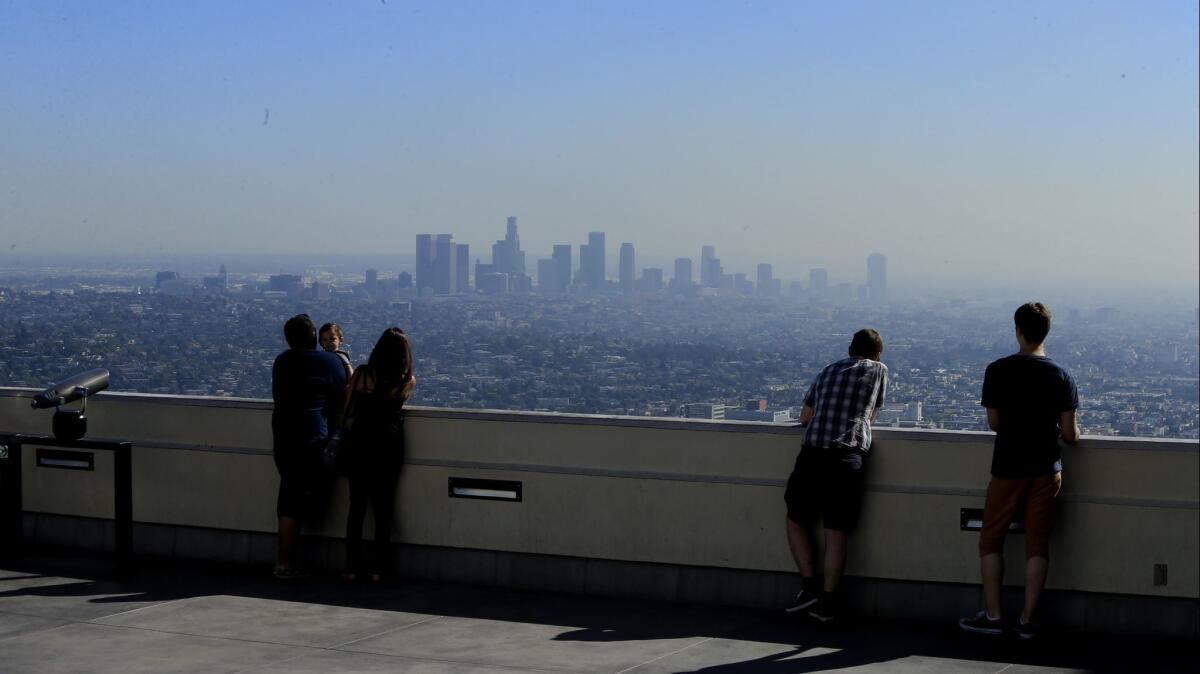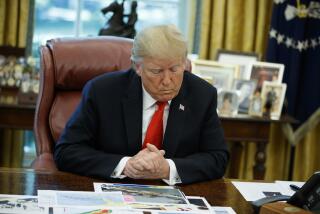Trump targets smog standards, ordering EPA to make it easier for companies to comply

President Trump took aim at federal air quality standards Thursday, directing the Environmental Protection Agency to relax restrictions on state governments and businesses that have been key to cutting smog.
In a memo, the president instructed EPA Administrator Scott Pruitt to more quickly review states’ smog-reduction plans, make it easier for businesses to get air quality-related permits and to evaluate health-based smog and soot standards to determine whether they “should be revised or rescinded,” among other directives.
Trump’s mandates came at the request of industry, which has long complained that federal air pollution rules are too strict and have sought the reversal of tougher Obama administration policies.
A statement by the EPA said the changes are necessary “to ensure efficient and cost-effective implementation” of air quality standards, and to further the administration’s push to slash environmental regulations. The actions will reduce “unnecessary impediments to new manufacturing and business expansion essential for a growing economy,” according to the memo signed by Trump.
Environmentalists warned the president’s directives would allow for increased air pollution, more cases of asthma and other respiratory diseases. They also questioned the legality of those actions, saying some are in violation of the federal Clean Air Act.
“It is a polluter’s dream,” said Frank O’Donnell, president of the nonprofit Clean Air Watch. “Add them up and this amounts to a significant weakening of the current system for reducing emissions of widespread air pollutants, and it creates a greater risk for public health damage.”
The president’s move has the potential to slow progress battling smog, particularly in California, where millions in the Inland Empire and San Joaquin Valley breathe the nation’s worst-polluted air.
The California Air Resources Board is reviewing the document, a spokesman said.
Ross Eisenberg, a vice president for the National Assn. of Manufacturers, in a statement called the move “a tremendous step forward in helping manufacturers navigate the maze of federal air permitting regulations,” including required studies that “have become so complicated that it can be nearly impossible for manufacturers to secure the needed approvals just to open a new facility.”
Among the most contentious changes Trump ordered is one that would allow companies that want to pollute in an area where the air already violates federal health standards to get their permit by obtaining offset credits from a firm in an entirely different area. Environmentalists say such a change undermines the entire point of the offset program: to limit overall emissions in the areas where air is dirtiest.
“The courts have said on more than one occasion that the Clean Air Act does not allow that,” said Janet McCabe, who ran the EPA’s air quality office under the Obama administration.
The changes would also give a break to companies struggling to get permits in California and other parts of the country where poor air quality is made worse by pollution that blows across the Pacific Ocean from Asia.
The rule change could help some regions come into compliance, at least on paper, by allowing greater consideration of foreign air pollution, wildfires and other “exceptional events” that can be used to exempt them from some requirements.
The president’s directive expressed frustration with how often the federal government keeps tightening the rules around what levels of smog and soot are safe. Each new revision, his memo said, “triggers numerous new planning, permitting, and other requirements” that burden states and regulated industries and can affect federal transportation project funding.
Trump also ordered regulators to start considering how difficult it would be for industry to obtain air quality standards before setting them. It is another move that riled environmentalists, who say the Clean Air Act specifically prohibits such considerations. Under the act, they say, such public health determinations must be driven only by the best available science.
The president’s directive, in that regard, targets the science the EPA uses in setting federal air quality standards, instructing it to “develop criteria to ensure transparency in the evaluation, assessment, and characterization of scientific evidence.”
Air quality advocates say Trump’s move is aimed at discrediting large-scale scientific studies involving the health records of tens of thousands of participants who were assured their privacy would be protected.
McCabe said that many of the provisions in the president’s memo were familiar.
“These things were all on a wish list the industry brought us multiple times when I was at the agency,” McCabe said.
More to Read
Sign up for Essential California
The most important California stories and recommendations in your inbox every morning.
You may occasionally receive promotional content from the Los Angeles Times.












